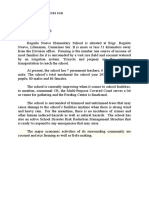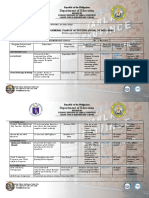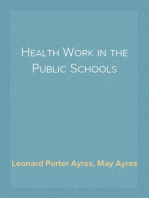Research Proposal First
Research Proposal First
Uploaded by
Shalla Gayle B. BillanoCopyright:
Available Formats
Research Proposal First
Research Proposal First
Uploaded by
Shalla Gayle B. BillanoCopyright
Available Formats
Share this document
Did you find this document useful?
Is this content inappropriate?
Copyright:
Available Formats
Research Proposal First
Research Proposal First
Uploaded by
Shalla Gayle B. BillanoCopyright:
Available Formats
HOLY ANGEL UNIVERSITY Institutional Planning, Research, and Publications Office RESEARCH PROPOSAL
University Research Incentive Program ============================================================= PERSONAL BRIEF [Kindly fill out the box for each researcher involved in the study. Copy as
many boxes as needed.] Name College/Department Employment Status Faculty/Personnel Rank College Degree/ Year Graduated/School Graduate Degree/s Year Graduated/School E-mail Addresses Shalla Gayle B. Billano CEA - Architecture Regular Probationary Guest Lecturer College Instructor/ Instructor 1 BS Architecture/ 1998/ University Santo Tomas MS Architecture/ Oct 2010/ University of Santo Tomas Graduate School sgb_arch@yahoo.com Mobile Phone No. 09192442892
============================================================= PROPOSAL DETAILS [Please type the required information inside the boxes provided for
this purpose. Boxes expand in length as more text is typed in.]
TITLE OF PROPOSED STUDY
The title should briefly and simply reflect the main topic of the paper, identifying the actual variables or theoretical issues to be investigated and the relationship between them. Avoid words that serve no useful purpose, as well as abbreviations. Recommended length is 10-12 words.
Land Use Pattern of Holy Angel University Campus
INTRODUCTION*
Please state your research problem/s, emerging from/related to, your research background of properly cited related literature and studies. Universities can nowadays be regarded as small cities due to their large size, population, and the various complex activities taking place in campuses, which have some serious direct and indirect impacts on the environment (Alshuwaikhat & Abubakar, 2008). Holy Angel University (HAU) being a dynamic university can now be perceived as a small city with its growing population, increase in the number of program offerings and the continuous modernization of facilities. HAU campus has undergone major changes for the last decade and is still changing through a complex process of renovating, demolishing and constructing in a loop pattern. The 7hectare campus, which used to be a vast open land has increased in its built-up areas with the various buildings erected from 1940s. As a result, open spaces, which act as lungs to the campus are now slowly being replaced by taller buildings. This increase in the built-up areas translates as land use and land cover (LULC) change. LULC change is one of the most visible results of humans modification of the terrestrial ecosystem, and it has a significant impact on the local, regional, and global environment (Weng, 2001). HAU is a
living testimony of the urbanization issues, universities face nowadays. Through a timeseries analysis, the research may provide a general description of the evolution of the land use pattern of the campus that could support future plans for HAU and hopefully, mitigate uncontrolled changes. Lay down your research questions and discuss how the answers to the said questions (results) will contribute to the solution of the problem/s. How much land use and land cover change did the campus go through since the 1940s? What is the current percentage of site occupancy (PSO) of HAU buildings compared to the recommended PSO of the National Building Code of the Philippines? Is the campus nearing its saturation level in terms of development? What is the recommended height of buildings for the HAU campus? State the significance of your study to theory and/or practice. The study aims to present the different trajectories of HAU campus development, its land use pattern and land cover changes from 1940 to 2010 that will eventually lead to the 2020. Please describe the conceptual framework of your study. This framework consists of: (1) your chosen approach to address the research problem/s, (2) the variables you will consider in the study, with their operational definitions, (3) the hypotheses and/or propositions of the study, with a rationale or justification for each, and (4) model equation/s, if applicable. Include a diagram or a figure to show the key concepts and describe how they interplay with each other. The literature and studies cited in this section should focus on justifying any of the components of the research framework.
1) Evolution of the Land Use Pattern 2) Physical determinants: buildings List of buildings, date of construction, purpose 2) Socio-economic determinants: student population & program offerings analysis on
population increase or decrease and reasons for the new program offerings 3) The land use and land cover of HAU campus can still be balanced. A development guide can help mitigate the loop pattern of construction and demolition activities.
METHOD
Participants or Subjects Identify and describe the population and the sample of your research study. Discuss your sampling plan in regard to sample size determination, and sampling and selection procedures. HAU Buildings, Student Population and Program Offerings. These will be based on actual records which will be gathered through purposive interview. A Survey that entails size determination and sampling will not be utilized. Instruments/Sources of Data Include sources of data, instruments, and questionnaire/s to be used; how these were or are to be developed, with proofs/tests of validity and reliability. GIS (On-line) Ocular Survey Registrars Office ECMO Office of the Academic Affairs Procedure Discuss the steps to be employed in gathering/collecting of data, e.g. how the instruments will be administered among the participants. Gathering of Data will start with an ocular survey in order to have an actual exposure of the study area. The secondary data available from the different HAU offices coupled with purposive interviews will help collate the raw data on hand. Data Analysis Plan To answer each of your problems, disclose what data you are going to process and analyze, and specifically identify what quantitative/statistical and/or qualitative techniques or tools you are planning to use to perform such analyses. The literature and studies cited in this section should focus on clarifying the choice of methods and procedures. Use additional sheets, if needed. Time Series Analysis of the following: 1) Tracing the HAU Buildings constructed from 1940 to 2010 2) Student Population from 1940 to 2010 3) Program Offerings from 1940 to 2010 The Time Series analysis will focus on the important trajectories on the Physical Development of HAU.
REFERENCES
Please list down with complete APA bibliographic entries all the journal articles, books, electronic materials, conference proceedings, monographs, professional correspondences and other scholarly literature which (1) you have used, and (2) you are planning to use in your study
Ballesteros, M. (2000). Land Use Planning in Metro Manila and the Urban Fringe: Implications on the Land and Real Estate Market. Philippine Institute for Development Studies. Discussion Paper 20. Blanco, Hilda et al. (2009). Hot, congested, crowded and diverse: Emerging research agendas in planning. Elsevier Ltd. Progress in Planning 71: 153205. (www.sciencedirect.com)
Chan, Edwin & Yung, Esther H.K.(2004). Is the development control legal framework conducive to a sustainable dense urban development in Hong Kong? Habitat International 28: 409426. Davis, A., Pijanowski, B., Robinson, K. and Engel, B. (2009). The Environmental and economic costs of sprawling parking lots in the United States. Land Use Policy. Dela Cruz, Leland Joseph. (2001). Estimating the Determinants of Land Conversion. Department of Economics, Ateneo de Manila University. Ferman, B. and Kaylor, B. (1999). Building the Spatial Community: A Case Study of Neighborhood Institutions. Policy Studies Review, 18 (4). Hansen, J. and Lehmann, M. (2006). Agents of change: universities as development hubs. Journal of Cleaner Production 14: 820-829. Hardie, I., Parks, P., Gottleib, P. and David Wear, D. (2000). Responsiveness of Rural and Urban Land Uses to Land Rent Determinants in the U.S. South. Land Economics, 76 (4): 659-673. Jansen, L. and Di Gregorio, A. (2003). Land-use data collection using the land cover classification system: results from a case study in Kenya Land Use Policy, 20: 131-148.
El-Khoury, R. and Robbins, E. (2004). Shaping the City: Studies in History, Theory and Urban Design. Great Britain.
Lukmana, Rebeka et al.(2009). Towards greening a university campus: The case of the University of Maribor, Slovenia.Elsevier Ltd., 1-6. Lynch, Lynch. (1960). The Image of the City. The MIT Press.
Marwell, Nicole P. et al. (2003). University-Community Partnerships: New York City University-Non Profit Information Transfer Project Report. Working Paper. Center for Urban Research and Policy. Columbia University. Santamouris, M. et al. (2007). Using intelligent clustering techniques to classify the energy performance of school buildings. Elsevier Ltd. Energy and Buildings 39: 4551. (www.sciencedirect.com) Weber, C & Puissant, A.(2003).Urbanization pressure and modeling of urban growth: example of the Tunis Metropolitan Area. Elsevier Ltd. (www.sciencedirect.com), 341-352. Xiao, Honglin & Weng, Qihao. (2006). The impact of land use and land cover changes on land surface temperature in a karst area of China. Elsevier Ltd. (www.sciencedirect.com), 245-257. Yin, Zhi-Yong et al. (2005). Changes in urban built-up surface and population distribution patterns during 19861999: A case study of Cairo, Egypt. Elsevier Ltd. (www.sciencedirect.com), 595-616.
PROPOSED TIMETABLE [Kindly fill out the following table with the activities planned for
the research/study]
Activit y No.
1
Activity Description
Ocular Survey
Duration
2 months
PreStarting requisite Date Activity
Check GIS data Jan. 15, 2012
Ending Date
Mar. 15, 2012
3 4 5
Interview and Data Gathering from the ECMO Office, Office of the Academic Affairs and Registrars Office Plotting of the Site Development Plan of HAU (based on the trajectories) Computations based on the National Building Code of the Philippines Sorting and Collating of the data for the whole research
2 months
available on-line Activity 1
Mar. 16, 2012 May 16, 2012 July 16, 2012 Sept. 16, 2012
May 15, 2012 July 15, 2012 Sep. 15, 2012 Dec. 15, 2012
2 months 2 months 3 months
Activities 1&2 Activities 1,2 & 3 Activities 1, 2, 3 & 4
LOGISTICS REQUESTED [Kindly fill out the table with the resources and logistical
requirements needed for the conduct of the research.]
Logistics Required
Justification
Date
Amount
(Show computations)
Total DEANS/OFFICE HEADS RECOMMENDATIONS
Action Recommended: for Approval for Disapproval
Type of Research Incentive Recommended: Equivalent Load of ____ units during the ________ Semester of School Year _________ Cash
Engr. Doris C. Bacamante
Printed Name & Signature of the Dean/Head of Office Date
Submitted by: [Please have all participating researcher/s sign] Shalla Gayle B. Billano
Printed Name & Signature of the Faculty Member/Staff Note to the Researcher/s
Jan. 2012
Date
Please submit the accomplished form to the University Research and Planning Office: (a) before the start of the academic term if the incentive applied for is an equivalent load, or (b) anytime if the incentive applied for is cash. Thank you.
You might also like
- Diversity in WorkplaceDocument43 pagesDiversity in WorkplaceRazin GajiwalaNo ratings yet
- Aged Care Nursing A Guide To Practice.Document322 pagesAged Care Nursing A Guide To Practice.sdamio100% (1)
- SHS - HumssDocument30 pagesSHS - HumssGlaiza SaltingNo ratings yet
- School Profile Form For SPSTE Implementing Schools SY 2015-2016Document7 pagesSchool Profile Form For SPSTE Implementing Schools SY 2015-2016Irvin EcalnirNo ratings yet
- Narrative Report: World Teachers' Day Celebration October 4, 2019Document2 pagesNarrative Report: World Teachers' Day Celebration October 4, 2019Arvin VillagarciaNo ratings yet
- Ddesignation of School Information and Communications TechnologyDocument3 pagesDdesignation of School Information and Communications TechnologyTawagin Mo Akong MertsNo ratings yet
- PHA Disaster PreparednessDocument42 pagesPHA Disaster PreparednessShirnyl Dorothy Magos100% (1)
- Reading Plan Grade I 2018 - 2019 Date Activity Persons Involved Materials Needed Expected OutcomeDocument4 pagesReading Plan Grade I 2018 - 2019 Date Activity Persons Involved Materials Needed Expected OutcomeluckyannNo ratings yet
- Training Matrix On SBM MentoringDocument1 pageTraining Matrix On SBM MentoringGenevenNo ratings yet
- Sto. Rosario National High School School Contingency Plan For Covid-19 Resurgences in The CommunityDocument21 pagesSto. Rosario National High School School Contingency Plan For Covid-19 Resurgences in The CommunityZaldy Roman MendozaNo ratings yet
- SSG by Lws 2016 - 2017Document7 pagesSSG by Lws 2016 - 2017Howard100% (1)
- Thesis Blank - MCDocument20 pagesThesis Blank - MCJepoy MacasaetNo ratings yet
- Department of Education: Republic of The PhilippinesDocument7 pagesDepartment of Education: Republic of The PhilippinesGrace CaritNo ratings yet
- Basco Proposal On Learning Resource DevelopmentDocument9 pagesBasco Proposal On Learning Resource DevelopmentLea Magpantay-bascoNo ratings yet
- Collateral Reading On "Ongoing Teacher Training by Dep-Ed" by Richen S. Makig-AngayDocument12 pagesCollateral Reading On "Ongoing Teacher Training by Dep-Ed" by Richen S. Makig-AngayRichen Makig-angay100% (2)
- Schools Division of Nueva Ecija SDO Guimba East Annex: Annex V. I. ObjectivesDocument4 pagesSchools Division of Nueva Ecija SDO Guimba East Annex: Annex V. I. ObjectivesNatividad Jo Ann CuadroNo ratings yet
- San Felix Es-Project Proposal - Google DriveDocument4 pagesSan Felix Es-Project Proposal - Google DriveNimfa LozadaNo ratings yet
- Anti Bullying PolicyDocument4 pagesAnti Bullying PolicyathersleysouthNo ratings yet
- PPAs WinSDocument2 pagesPPAs WinSKing Ace FrancoNo ratings yet
- Berf ResearchDocument9 pagesBerf ResearchReliza Amahan SenoNo ratings yet
- SPTVE - Special Program in Technical-Vocational EducationDocument17 pagesSPTVE - Special Program in Technical-Vocational EducationTyrhone CoNo ratings yet
- Communication LetterDocument3 pagesCommunication LetterJubylyn AficialNo ratings yet
- Activity Proposal I. Title of The Program Grand Ball 2020 II. Target Participants and Number of Participants Participants Male Female TotalDocument8 pagesActivity Proposal I. Title of The Program Grand Ball 2020 II. Target Participants and Number of Participants Participants Male Female TotalHADJA KAREN GALLARDO0% (1)
- LSDE May 19, Sunday 2013Document8 pagesLSDE May 19, Sunday 2013LeyteSamar DailyExpressNo ratings yet
- LNHS Contingency Plan1Document26 pagesLNHS Contingency Plan1Liezel CauilanNo ratings yet
- Department of EducationDocument10 pagesDepartment of EducationRosario Perez OcamiaNo ratings yet
- Script ManCom AparriDocument2 pagesScript ManCom AparriVer BadduNo ratings yet
- District BKD Election ProgramDocument12 pagesDistrict BKD Election ProgramMariah Johanna AlcalaNo ratings yet
- Bnes Contingency Plan 2020Document23 pagesBnes Contingency Plan 2020bryanNo ratings yet
- Barucboc National High School: Schools Division Office of IsabelaDocument3 pagesBarucboc National High School: Schools Division Office of IsabelaPrincess Canceran BulanNo ratings yet
- Region Memo CLMD 166 ONSITE MONITORING AND PROVISION OF TECHNICAL ASSISTANCE TO SCHOOLS IMPLEMENTING DISTANCE LEARNINGDocument14 pagesRegion Memo CLMD 166 ONSITE MONITORING AND PROVISION OF TECHNICAL ASSISTANCE TO SCHOOLS IMPLEMENTING DISTANCE LEARNINGArnold A. BaladjayNo ratings yet
- Recommended Programs, Projects, and Activities of The Student Government For School Year 2021-2022 DM 055, S. 2021Document31 pagesRecommended Programs, Projects, and Activities of The Student Government For School Year 2021-2022 DM 055, S. 2021Ash ArrearocNo ratings yet
- Reflection of The SeminarDocument2 pagesReflection of The SeminarJessete YaralNo ratings yet
- Action ResearchDocument1 pageAction ResearchJohanna Christine CaballesNo ratings yet
- Nabuslot National High SchoolDocument4 pagesNabuslot National High SchoolPearl Arianne MontealegreNo ratings yet
- READING - Project Monitoring Report Form READDocument3 pagesREADING - Project Monitoring Report Form READMhia DulceAmorNo ratings yet
- Sto Domingo DRRMDocument36 pagesSto Domingo DRRMBrad-m CdrrmoNo ratings yet
- Brigada Program 2019 NewDocument2 pagesBrigada Program 2019 NewKarel Anne Bansil CunananNo ratings yet
- Capacity Building On Gender Sensitivity Cum Child ProtectionDocument31 pagesCapacity Building On Gender Sensitivity Cum Child ProtectionReina montesNo ratings yet
- Department of Education: Republic of The PhilippinesDocument6 pagesDepartment of Education: Republic of The PhilippinesGLORYLYN ECHOGANo ratings yet
- Innovation in The Classroom KwekDocument39 pagesInnovation in The Classroom KwekSamuel BabalolaNo ratings yet
- Accomplishment Report 2018Document10 pagesAccomplishment Report 2018Reign-i FrancisquiteNo ratings yet
- Numeracy by GradeDocument6 pagesNumeracy by GradeJaqueline MontezoNo ratings yet
- Narrative Report On Mpre2018Document3 pagesNarrative Report On Mpre2018Maelena PregilNo ratings yet
- School Memorandum: Department of EducationDocument2 pagesSchool Memorandum: Department of EducationRaymund P. Cruz100% (2)
- Smes - Innovation ProposalDocument6 pagesSmes - Innovation ProposalSonny MacaspacNo ratings yet
- Nqesh Domain 5Document18 pagesNqesh Domain 5rosalito pepito100% (1)
- ACTIVITY PROPOSAL For Graduation KESDocument5 pagesACTIVITY PROPOSAL For Graduation KESAILEEN JAVIER100% (1)
- Action Research - Play Based Learning As A Meato ResolveDocument16 pagesAction Research - Play Based Learning As A Meato ResolveReunion MabasaNo ratings yet
- Digital Forensics and Investigation Request LetterDocument2 pagesDigital Forensics and Investigation Request LetterJoebellNo ratings yet
- Action Research 2019 MatrixDocument3 pagesAction Research 2019 MatrixSandra Neri JacalneNo ratings yet
- Integration of Action Civics Strategic Intervention Materials (ACSIM) For Improved Learners' Performance in Araling Panlipunan 8Document10 pagesIntegration of Action Civics Strategic Intervention Materials (ACSIM) For Improved Learners' Performance in Araling Panlipunan 8IOER International Multidisciplinary Research Journal ( IIMRJ)No ratings yet
- Pir Tool 1Document9 pagesPir Tool 1Chembie Mariquit LaderaNo ratings yet
- Department of Education: Republic of The PhilippinesDocument6 pagesDepartment of Education: Republic of The PhilippinesJay Lord BacaniNo ratings yet
- Principle 1 Leadership and Governance Arlene Necio Stephen DaplasDocument16 pagesPrinciple 1 Leadership and Governance Arlene Necio Stephen DaplasDharwin AlcantaraNo ratings yet
- P D II: Piaz National High SchoolDocument2 pagesP D II: Piaz National High SchoolMark Ralston GarciaNo ratings yet
- Schools Division Office of IsabelaDocument3 pagesSchools Division Office of IsabelaEstela Leaño Failma PonesNo ratings yet
- COC For SPG 2018 VersionDocument3 pagesCOC For SPG 2018 VersionRyan Carl Larong BicoNo ratings yet
- Community Mapping (Region)Document40 pagesCommunity Mapping (Region)Ma Ann Jubay Limbaga-BasaloNo ratings yet
- Department of Education: Republic of The PhilippinesDocument3 pagesDepartment of Education: Republic of The PhilippinesGhie Yambao SarmientoNo ratings yet
- How Can I Check My Dissertation For PlagiarismDocument7 pagesHow Can I Check My Dissertation For Plagiarismprenadabtag1981100% (1)
- Testıng 2Document28 pagesTestıng 2sevilllomenNo ratings yet
- Intertek INMETRO 384 2020 UpdateDocument2 pagesIntertek INMETRO 384 2020 Updatetechojak422No ratings yet
- Jurnal Internasional 4Document9 pagesJurnal Internasional 4Wisnu Sandika 1803110443100% (1)
- Lesson 3 - Research EthicsDocument15 pagesLesson 3 - Research EthicsPrincess AguiNo ratings yet
- A Classification of Survey Platforms - Hydro InternationalDocument16 pagesA Classification of Survey Platforms - Hydro InternationalMuhamad AlfaniNo ratings yet
- Predicting CBR Value From Index Properties of Soils Using Expert SystemDocument7 pagesPredicting CBR Value From Index Properties of Soils Using Expert SystemArunavNo ratings yet
- Book 2 PROF ED - Assessment of Learning 2Document15 pagesBook 2 PROF ED - Assessment of Learning 22001399No ratings yet
- Financial Literacy and Financial Performance of Small and Medium Enterprises SMES Among Selected Firms in Lagos StateDocument13 pagesFinancial Literacy and Financial Performance of Small and Medium Enterprises SMES Among Selected Firms in Lagos StateEditor IJTSRDNo ratings yet
- Involvement To Community Action PlanDocument47 pagesInvolvement To Community Action Plangania carandangNo ratings yet
- Short Notes IAS CS365 2021 Volume 1Document15 pagesShort Notes IAS CS365 2021 Volume 1Editing WorkNo ratings yet
- Apo Nid124756 PDFDocument53 pagesApo Nid124756 PDFIsuru JayarathnaNo ratings yet
- Capilla 2016Document26 pagesCapilla 2016Teddy IswahyudiNo ratings yet
- ROLLNODocument1 pageROLLNOVinod KumarNo ratings yet
- Computer-Based Teaching Module DesignDocument8 pagesComputer-Based Teaching Module DesignINGELPOWER ECNo ratings yet
- Marketing ManagerDocument2 pagesMarketing Managerapi-122238313No ratings yet
- Azeip Family SurveyDocument1 pageAzeip Family Surveydana_ionescu2069No ratings yet
- CASP Systematic Review Checklist 2018 - Fillable FormDocument4 pagesCASP Systematic Review Checklist 2018 - Fillable FormHeartfelt LoveNo ratings yet
- AI Adoption in The Enterprise 2020Document20 pagesAI Adoption in The Enterprise 2020jagaenatorNo ratings yet
- ISTQB Latest Sample Paper 8Document4 pagesISTQB Latest Sample Paper 8Ramesh NvNo ratings yet
- Grade 10 - Coastal Management Assessment - 2021Document12 pagesGrade 10 - Coastal Management Assessment - 2021Rayan SibariNo ratings yet
- OverviewDocument2 pagesOverviewabdisamed awliyoNo ratings yet
- CHAPTER 3 - RESEARCH METHODOLOGY: Data Collection Method and Research ToolsDocument10 pagesCHAPTER 3 - RESEARCH METHODOLOGY: Data Collection Method and Research Toolsxyz abcNo ratings yet
- Factors Affecting On-Line Shopping Behaviour of ConsumersDocument5 pagesFactors Affecting On-Line Shopping Behaviour of ConsumersshivacrazzeNo ratings yet
- Mahmud 2024 IOP Conf. Ser. Earth Environ. SciDocument8 pagesMahmud 2024 IOP Conf. Ser. Earth Environ. SciNickson AwangNo ratings yet
- Lesson Plan 1 Semester 5Document4 pagesLesson Plan 1 Semester 5api-338878533No ratings yet
- KPO Case Study 01Document3 pagesKPO Case Study 01rameshkoutarapuNo ratings yet
- Linhphuong Nguyen Bsbmgt615 Task 2 Attempt 1Document8 pagesLinhphuong Nguyen Bsbmgt615 Task 2 Attempt 1Cheryl PhamNo ratings yet

























































































